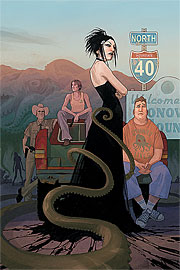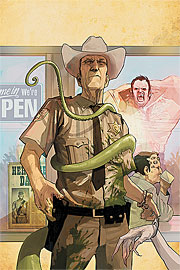
Zombos Says: Excellent
The residents of Conover County are in the grip of an eldritch, surreal, horror like the one John Trent faced in John Carpenter's In the Mouth of Madness. Changing everyone into demons, devils, or potential deliverers from the green sticky spawn of the stars, the-sleeper-awakened, Cthulhu, writer Aaron Williams and illustrator Fiona Staples leaven their apocalyptic despair with dry humor and back end o' the Bible bad monsters.
Now Entering Conover County, North 40, Issue 1 — The water here must make people retarded…
One very bored Goth girl, Dyan, and her eager to please, slow-to-glow, acolyte, Robert, wile away the time by reading from a restricted–but cool looking–book at the local library. Robert remarks "D&D geeks make things like this all the time out of old dictionaries and epoxy resin." Paging through it, they inadvertently read that spell; you know, the one that opens the gate-never-to-be-opened that lies between our backyard and theirs.
And theirs is some backyard.
 Events happen quickly in the hayseed town of Lufton. People start changing in one of three ways: loathsomely, powerfully, or not at all. Sheriff Morgan falls into the not-at-all category, but he must deal with the people who fall into the other two. For them, the transformation can lead to bad personality traits becoming really bad for everyone else.
Events happen quickly in the hayseed town of Lufton. People start changing in one of three ways: loathsomely, powerfully, or not at all. Sheriff Morgan falls into the not-at-all category, but he must deal with the people who fall into the other two. For them, the transformation can lead to bad personality traits becoming really bad for everyone else.
Helping the Sheriff is Luanne, who is powered up with a World of Warcraft kind of far sight, so she can tell him what's happening around town and direct him accordingly, and Wyatt, who can fly and becomes impervious to harm. Stirring up trouble is David–make that a giant-sized trouble–and his backroads kin, and the townsfolk who have metamorphosed into nasty hungry creatures or undead ones.
The witch, Marguritte DeVris, instructs her apprentice Amanda–a halfie–from the shadows. She empowers Amanda with a symbol of authority, a scythe, and the always-useful-in-chaos-magic sigils to battle the darkness.
Staples disarming artwork is both humorous and serious when needed–her character's faces are full of life–as Conover's predicament worsens, and Williams dialog and narrative are concisely measured for each character and situation, and especially for Sheriff Morgan, who remains unrattled by the chaos around him and surprisingly (suspiciously?) resourceful at handling its more challenging moments.
An' the Word Was Law, North 40, Issue 2 — Somethin' went wrong with the world in Conover County last night, and folks was just startin' to see how deep this well was…
In issue two, Amanda arrives in Conover County to join the fight for salvation, Wyatt tries to come to grips with his couch-potato dad who has turned into a potato on the couch, sprouts and all, and the local high school dance is still on in spite of the dangers. Teenagers. Sheriff Morgan also has his hands full with the redneck, misbehavin' Atterhulls and David, who can toss around big cars like Matchbox die-casts.
The opening gruesome splashpage sets the tone, and while I am not sure whether Staples and Williams did the panel layouts together or it is just Staples' arrangement, each page moves the story smoothly along with an economic, yet stylistically expressive, visual storytelling. The colorization for daylit scenes is comprised of rustic tones, reinforcing the small town countryfide quality of Lufton.
A Time to Mourn, an' a Time to Dance, North 40, Issue 3 — Conover County's past is steeped in hate n' blood. The lines was drawn over a hundred years ago, an' nobody's erased 'em since…
Night. A giant robot. Zombies crash the high school dance. The Atterhulls get help from Granny, who can now see with her new eyes (a very clever way to also give her far sight), and Dyan–filled with the spirit of vengeance–becomes a key player in the fight to save Lufton, but for the wrong side. Williams and Staples ante up with issue three; there is more dialog, more tension on every page as the situation worsens. Old rivalries heat up and Sheriff Morgan needs Wyatt to focus more on helping him rather than spraying his dad with a water bottle. Staples draws the variously afflicted teenagers–some are glowing ghosts, some are stalk-eyed, some are just plain undead, humorously terrifying.
North 40 flips the black flavors of American Gothic's relationships and characters, salt's them with the simplicity of The Walking Dead's direness, and then runs amok with monsters, mayhem, and a Stephen King's worth of darkness stretching across the landscape. And with all of this powered by Lovecraft's leviathan from the stars, the reading experience is exhilarating.
